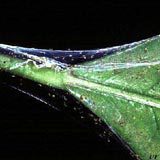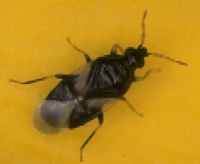
Spider Mites:
Spider mites are serious garden pests, easily spread, and not always easy to control. There are two kinds that cause gardeners the most problems: Tetranychus urticae, the twospotted spider mite, and Oligonychus ununguis, the spruce spider mite. There are others that are more host specific and live on specific plants such as the boxwood spider mite and the oak mite.
The twospotted spider mite is a hot weather mite, and now that Central Texas is experiencing both a heat wave and a bad drought, conditions are prime for them to infest your garden. If you notice leaves on a plant with pale freckled spots or a fine webbing like a spiderweb all over the leaves, you have spider mites. To positively identify them, put a white cloth under the plant and tap it. The mites will fall onto the cloth, and you will see little red or black specks crawling around. Spider mites are an arachnid in the spider class (hence the web), and are very tiny (0.4mm), but if you use a magnifying glass you will see a little mite with eight legs and an oval body without any distinguishable head. Even though they are so small they can multiply fast, and cause much damage or death to plants in a short time. They have piercing mouth parts and suck the juices out of individual plant cells, causing the white noticeable speckling on the leaves. Usually they feed on the underside of the leaves, and can also use their webs like little parachutes to travel great distances on the wind.
The twospotted spider mite is a pest of more than 180 host plants including many agricultural plants such as avocados, cotton, as well as nursery plants, houseplants, and weeds. They like it hot and dry when the plant juices are concentrated with nutrients, and the plants are weakened by the stress of the heat and lack of ample water.
The spruce spider mite is a cool weather mite on many types of evergreens including junipers, arborvitae and pines. This spider mite goes dormant when the temperature is over 90F, and become active in the fall when it cools down. The problem with the spruce spider mite is that evergreens don't show the white spotting on their needles the way deciduous plants do, and the damage done that winter won't be apparent until the trees turn yellow during the summer.
Control of spider mites is not difficult for home gardens. Just spray the affected plants off with a stream of water and knock off the webs. If there is adequate rain, it does the same thing and that is why spider mite infestation is the worst during dry conditions. During a drought, they multiply without interference, and the garden can develop a bad infestation. Once they get started, the water spraying will have to be on a regular basis, because they will climb back onto the plants and begin all over again. When you water your garden, check for the white freckled leaves, and webbing and gently, but thoroughly, spray down the plants, trying to hit the underside of the leaves. This will knock them off the plant and interfere with their reproductive cycle. As it is with all pests in the garden, try to keep them under control, and don't expect to eradicate them all. If an annual plant, such as a merigold, is simply overwhelmed with webbing, the best thing to do is just pull it up and put it in your trash bin. For perennials, keep an eye on their favorite hosts such as rosemary, buddleia butterfly shrubs, and other shrubs attractive to butterflies, for they like them, too. I find that in my garden the first plants to be attacked are rosemary, merigold, and cosmos. If I keep an eye on them, and control the spider mites on those plants, I can keep the spider mites off the rest of the garden pretty well.
Farmers and vegetable producers have a more difficult problem, for common pesticides such as Sevin does not kill mites. There are commercial miticides available. Research online or check with your county agent. If you are attempting organic gardening, then things are more difficult. Try to keep your plants hydrated and healthy. Amend your soil to a neutral pH, keep the plants mulched to retain water and cool the roots. If a spider mite infestation begins, destroy the webs anyway you can. In greenhouse conditions where the mites are contained, there are preditory mites (N. fallacis) that you can buy and release to feed on spider mite pests. The problems with this is that excessive webbing can hinder their activity, and their optimum activity is at temperatures between 50-80F and high humidity. They will forage at higher temperatures, but only with a high humidity. If it is cooler than 50F they won't reproduce, and their life span is about one month.
Organic horticultural oil spray is also a recommended control for spider mites. This is a botanical oil with insecticidal properties, such as Neem oil, mixed with water and a little dish soap added to help the oil stick to the leaves. This is sprayed onto the plants. Personally, I believe the spraying with water is why this method controls the spider mites, and not the insecticidal oil. Regardless, you should not use a horticultural oil spray on water and heat stressed plants for it can burn them. A simple soap spray can be mixed and used, but it can also burn heat and drought stressed plants the same as the oil spray.
Spider mites:
Spider mites are serious garden pests, easily spread, and not always easy to control. There are two kinds that cause gardeners the most problems: Tetranychus urticae, the twospotted spider mite, and Oligonychus ununguis, the spruce spider mite. There are others that are more host specific and live on specific plants such as the boxwood spider mite and the oak mite.
The twospotted spider mite is a hot weather mite, and now that Central Texas is experiencing both a heat wave and a bad drought, conditions are prime for them to infest your garden. If you notice leaves on a plant with pale freckled spots or a fine webbing like a spiderweb all over the leaves, you have spider mites. To positively identify them, put a white cloth under the plant and tap it. The mites will fall onto the cloth, and you will see little red or black specks crawling around. Spider mites are an arachnid in the spider class (hence the web), and are very tiny (0.4mm), but if you use a magnifying glass you will see a little mite with eight legs and an oval body without any distinguishable head. Even though they are so small they can multiply fast, and cause much damage or death to plants in a short time. They have piercing mouth parts and suck the juices out of individual plant cells, causing the white noticeable speckling on the leaves. Usually they feed on the underside of the leaves, and can also use their webs like little parachutes to travel great distances on the wind.
The twospotted spider mite is a pest of more than 180 host plants including many agricultural plants such as avocados, cotton, as well as nursery plants, houseplants, and weeds. They like it hot and dry when the plant juices are concentrated with nutrients, and the plants are weakened by the stress of the heat and lack of ample water.
The spruce spider mite is a cool weather mite on many types of evergreens including junipers, arborvitae and pines. This spider mite goes dormant when the temperature is over 90F, and become active in the fall when it cools down. The problem with the spruce spider mite is that evergreens don't show the white spotting on their needles the way deciduous plants do, and the damage done that winter won't be apparent until the trees turn yellow during the summer.
Control of spider mites is not difficult for home gardens. Just spray the affected plants off with a stream of water and knock off the webs. If there is adequate rain, it does the same thing and that is why spider mite infestation is the worst during dry conditions. During a drought, they multiply without interference, and the garden can develop a bad infestation. Once they get started, the water spraying will have to be on a regular basis, because they will climb back onto the plants and begin all over again. When you water your garden, check for the white freckled leaves, and webbing and gently, but thoroughly, spray down the plants, trying to hit the underside of the leaves. This will knock them off the plant and interfere with their reproductive cycle. As it is with all pests in the garden, try to keep them under control, and don't expect to eradicate them all. If an annual plant, such as a merigold, is simply overwhelmed with webbing, the best thing to do is just pull it up and put it in your trash bin. For perennials, keep an eye on their favorite hosts such as rosemary, buddleia butterfly shrubs, and other shrubs attractive to butterflies, for they like them, too. I find that in my garden the first plants to be attacked are rosemary, merigold, and cosmos. If I keep an eye on them, and control the spider mites on those plants, I can keep the spider mites off the rest of the garden pretty well.
Farmers and vegetable producers have a more difficult problem, for common pesticides such as Sevin does not kill mites. There are commercial miticides available. Research online or check with your county agent. If you are attempting organic gardening, then things are more difficult. Try to keep your plants hydrated and healthy. Amend your soil to a neutral pH, keep the plants mulched to retain water and cool the roots. If a spider mite infestation begins, destroy the webs anyway you can. In greenhouse conditions where the mites are contained, there are preditory mites (N. fallacis) that you can buy and release to feed on spider mite pests. The problems with this is that excessive webbing can hinder their activity, and their optimum activity is at temperatures between 50-80F and high humidity. They will forage at higher temperatures, but only with a high humidity. If it is cooler than 50F they won't reproduce, and their life span is about one month.
Organic horticultural oil spray is also a recommended control for spider mites. This is a botanical oil with insecticidal properties, such as Neem oil, mixed with water and a little dish soap added to help the oil stick to the leaves. This is sprayed onto the plants. Personally, I believe the spraying with water is why this method controls the spider mites, and not the insecticidal oil. Regardless, you should not use a horticultural oil spray on water and heat stressed plants for it can burn them. A simple soap spray can be mixed and used, but it can also burn heat and drought stressed plants the same as the oil spray.
Spider mites:
Pictures courtesy of Wikipedia.org
spider mites. Picture courtesy of getridofthings.com
The minute pirate bug is a predator of spider mites.
The white speckling on the eggplant leaf is leaf damage done by spider mites.
The minute pirate bug is a predator of spider mites.
The white speckling on the eggplant leaf is leaf damage done by spider mites.
Pictures courtesy of Colorado State University Extension
Picture courtesy of Penn State Univ. (woodypests.cas.psu.edu)
For more information on spider mites check out www.wikipedia
For more information on spider mites check out www.wikipedia





